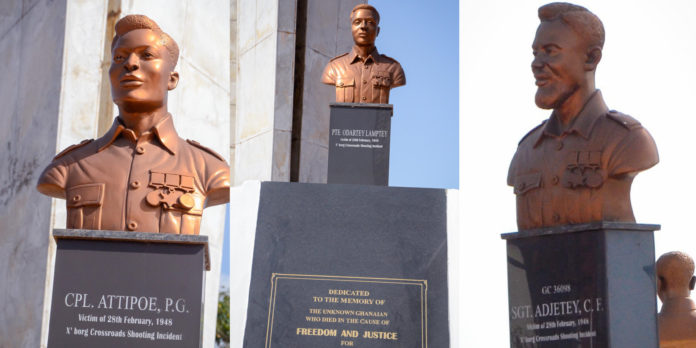Today marks the 75th anniversary of the February 28, 1948 crossroads shooting incident in remembrance of the three gallant, defenseless ex-servicemen, ex-Private Odartey Lamptey, ex-Corporal Patrick Attipoe and ex-Sergeant Cornelius Francis Adjetey.
They were murdered in cold blood whilst marching peacefully to the Osu Castle in Accra to present a petition to the then Governor of the Gold Coast, Sir Gerald Creasy.
Today in History, on 28th February 1948, the Gold Coast was rocked by riots following the killing of three Ghanaian WW2 veterans known as the 1948 riots.
The precursor to the 1948 riots was the boycott of European goods.
What caused the Riot
Nii Kwabena Bonne II organized a boycott of all European goods on 26th January 1948 in response to their high prices which was having a toll on the living conditions of people in the Gold Coast.
The economic boycott was very successful as it resulted in the closure of many shops.
On 20 February 1948, an agreement was reached as some of the foreign firms assented to reducing their overall profit margin from 75 to 50 per cent.
The Government announced over the radio that, as a result of the negotiations between the Chamber of Commerce and the Anti-Inflation Campaign Committee, prices on some imported goods would be reduced and the boycott would end on 28 February 1948.
The expectations of buyers were not met as anticipated. The same day, Veterans of world war two, who had fought with the Gold Coast Regiment of the Royal West African Frontier Force, organised a peaceful demonstration marching to Christiansborg Castle, Accra, Gold Coast (Ghana), to hand in a petition to the colonial governor, demanding that they receive end of war benefits and pay which they had been promised.
As they marched towards the Governor’s residence at the Christianborg Castle in Osu, the colonial police stopped them.
The British head of police, Superintendent Imray, ordered his officers to shoot at the protesters, but they shot in the air.
Imray, who was getting frustrated, grabbed a gun from one of the officers and shot into the crowd, killing three of the ex-servicemen – Sergeant Adjetey, Corporal Attipoe and Private Odartey Lamptey.
Some other protesters suffered varying degrees of injuries.
Angered by this unwarranted violence, against unarmed men, and continued injustices suffered by the population in general, people in Accra and other towns and cities took to the streets, attacking European and Asian businesses and property.
Aftermath of the Riots
The 1948 riots lasted five days. By 1st March, the colonial governor had declared a state of emergency and put in place a new Riot Act.

On 12th March the governor ordered the arrest of “The Big Six,” leading members of the UGCC, which included Kwame Nkrumah, as he believed they were responsible for orchestrating the disturbances.
The Big Six were incarcerated in remote northern parts of the country. They were detained but released a month later.
A year later, Kwame Nkrumah broke away from the UGCC and formed his own party – the Convention People’s Party (CPP) With the party’s motto of “self-government now” and other activities, the party won the admiration of many voters.
The 1948 riots marked a turning point in the political history of Ghana. In March 1957, less than a decade after the 1948 riots, Ghana gained her independence.

